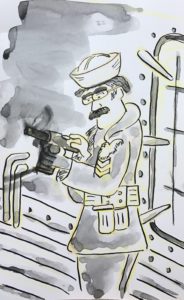 One of the most memorable moments for me during Operation Desert Storm was the night before hostilities began. I had duty as the Petty Officer the Watch on the forward quarterdeck of the Battleship Missouri. I knew something new was happening, something big was coming very soon.
One of the most memorable moments for me during Operation Desert Storm was the night before hostilities began. I had duty as the Petty Officer the Watch on the forward quarterdeck of the Battleship Missouri. I knew something new was happening, something big was coming very soon.
I knew things were different that day because I was ordered to place a magazine clip of 45 caliber ammunition into my US Navy issue Colt pistol.
At that point in my career as a United States Navy sailor, I had stood numerous watches as an armed guard. On my previous ship, the USS Cochrane, I and the others in the gunnery division were a part of the ship’s security force. All ships that are nuclear-capable have specialized security training associated with protecting the “special” weapons. We had orders to shoot anyone who attempted to enter the ASROC magazine without authorization. In fact, no one was ever permitted to enter that space alone; there was a “two-man rule” in force. I never had to shoot anyone. In fact, even in that situation, I was never given permission to load a clip of magazine of ammunition into my gun. Until Operation Desert Storm, whenever I was on duty as an armed guard, I had always carried an empty firearm with my ammunition safely tucked away on my belt.
The evening before Desert Storm commenced, the Officer of the Deck ordered me to go ahead and place a clip of ammo into my weapon. Even on the cusp of war, I wasn’t allowed to chamber a round. But it marked the first time in my naval career that I had loaded a clip and carried a gun with ammunition in it while I was on duty.
At that point, many rumors were flying about. There were rumors that the harbor had been mined. There were all kinds of rumors that something big was going to happen and people, possibly even us, were going to die.
Many of the news reports from earlier in the year talked about how hot it was for the people deployed in the Persian Gulf region. Operation Desert Shield started in August of 1990. Arriving in January of ’91, I never experienced that kind of heat while I was there. The night of January 15th while standing around outside aboard ship as Petty Officer of the Watch, it was quite chilly. We were all bundled up with our peacoats and gloves. The air in the port of Bahrain where we were anchored was cold and damp. There was an eerie feeling of uncertainty that night. We stood there together in the damp, mostly in silence.
I had transferred to the battleship Missouri for a number of reasons, partly because I was homesick. My previous ship, the Cochrane, was homeported in Yokosuka, Japan. My first two years in the Navy were spent in training in Illinois and I was able to visit home frequently. At the time, I could purchase a round-trip airline ticket to Kansas City for $50. After I was sent to Japan, I experienced strong bouts of homesickness and I was ready to come back to the states. As a history buff, having the opportunity to join the crew of the battleship Missouri in California appealed to me.
When deciding whether to stay with the Cochrane or move on the Missouri, I couldn’t have known that war was looming on the horizon. I previously had a taste of danger on the Cochrane as well when it was deployed to the Middle East in response to the USS Stark being struck by an Iraqi missile during the Iran/Iraq war in 1987.
Because the Cochrane was a “forward-deployed” US Navy warship, we were among the first additional ships to arrive in the military build-up after the Stark incident. However being in the weapons department, we were a little disappointed that our ship was not permitted to enter the Persian Gulf because of its lack of the Phalanx Close-In Weapon System (CIWS). So we were content to steam in circles in the Gulf of Oman just outside of the Persian Gulf off of the coast of Iran. As I remember it, there was an occasional Iranian fighter that would fly in our direction until we locked on with fire control radar, then it would skedaddle back home again. Not long after we left the region, another U.S. Navy ship of the same class as the Cochrane, the USS Hoel, was sent(without a CIWS system) into the Persian Gulf along with three other destroyers to destroy some Iranian oil platforms. Oh, how we in the gunnery division would’ve enjoyed some actual live fire missions! For weeks, we steamed endless circles in the Indian Ocean, then we leave and our sister ship gets the job!
It was a disappointment, but I couldn’t know at the time that some real naval gunfire missions were still waiting for me in the future aboard the Battleship Missouri. And one of the first signs to me that my ship was headed into war was that cold night on the quarterdeck when the OOD told me for the first time to load up a clip of ammo.
I never did actually “lock and load” that pistol, with a round of ammo in the chamber. I guess a young sailor can’t be trusted with a truly “loaded” weapon unless it is absolutely necessary. But once we were underway, my attention was directed towards much bigger guns.

